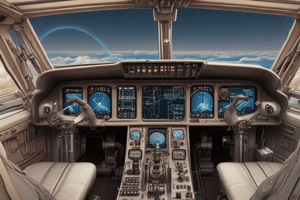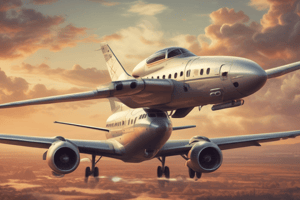Podcast
Questions and Answers
What type of actuators do large modern aircraft typically use?
What type of actuators do large modern aircraft typically use?
- Electro-mechanical actuators
- Electro-pneumatic actuators
- Hydraulic-only actuators
- Electro-hydraulic actuators (correct)
How are electro-pneumatic servos designed to operate when no electrical signal is present?
How are electro-pneumatic servos designed to operate when no electrical signal is present?
- Pistons are locked in place
- Only one valve opens
- Both valves remain open (correct)
- All valves are closed
What generates the position and rate feedback signals in an electro-mechanical servo for AC motors?
What generates the position and rate feedback signals in an electro-mechanical servo for AC motors?
- Position sensor only
- AC motor only
- Servo motor and clutch
- Tachogenerator and potentiometer (correct)
What is the key difference between power assisted and power operated flight control systems?
What is the key difference between power assisted and power operated flight control systems?
In a power assisted system, what initiates the movement of the control surface when the pilot pulls back on the control stick?
In a power assisted system, what initiates the movement of the control surface when the pilot pulls back on the control stick?
What role does the potentiometer play in the electro-mechanical servo?
What role does the potentiometer play in the electro-mechanical servo?
Which component is primarily utilized in power assistance to help the pilot move the control surface further?
Which component is primarily utilized in power assistance to help the pilot move the control surface further?
What is the primary function of the electro-magnetic valve in an electro-pneumatic servo?
What is the primary function of the electro-magnetic valve in an electro-pneumatic servo?
What is the purpose of applying feedback in command signal processing?
What is the purpose of applying feedback in command signal processing?
What distinguishes the E and I bar sensors from traditional transformers?
What distinguishes the E and I bar sensors from traditional transformers?
How do moving vane sensors differ in operation compared to E and I bar sensors?
How do moving vane sensors differ in operation compared to E and I bar sensors?
What does the output signal of an E and I bar sensor depend on?
What does the output signal of an E and I bar sensor depend on?
What phenomenon do I bar sensors measure in relation to flight attitude?
What phenomenon do I bar sensors measure in relation to flight attitude?
In what condition does a moving vane transducer output no signal?
In what condition does a moving vane transducer output no signal?
What role does programming play in aircraft control systems?
What role does programming play in aircraft control systems?
What happens in an I bar sensor when there is no external motion sensed?
What happens in an I bar sensor when there is no external motion sensed?
What happens to the Failure Sensor piston when a transfer valve is blocked?
What happens to the Failure Sensor piston when a transfer valve is blocked?
Which component is primarily responsible for detecting faults in the hydraulic actuator system?
Which component is primarily responsible for detecting faults in the hydraulic actuator system?
What is the role of the remaining non-failed half of a duplex actuator when one half fails?
What is the role of the remaining non-failed half of a duplex actuator when one half fails?
Before an automatic control system can be engaged in an aircraft, what must be fulfilled?
Before an automatic control system can be engaged in an aircraft, what must be fulfilled?
Which of the following components is NOT part of the hydraulic duplex servo-actuator schematic?
Which of the following components is NOT part of the hydraulic duplex servo-actuator schematic?
Gain scheduling is performed by which component in the actuator system?
Gain scheduling is performed by which component in the actuator system?
What condition occurs when P1 + P4 is greater than P2 + P3?
What condition occurs when P1 + P4 is greater than P2 + P3?
What is an important feature of the duplex actuator during a failure?
What is an important feature of the duplex actuator during a failure?
What role does the servo unit play in a power operated control system?
What role does the servo unit play in a power operated control system?
What is one main advantage of directly operating the hydraulic power unit?
What is one main advantage of directly operating the hydraulic power unit?
In a power operated control system, what addition is necessary to provide pilot feedback?
In a power operated control system, what addition is necessary to provide pilot feedback?
Which component operates the main control valve in an electro-hydraulic actuator system?
Which component operates the main control valve in an electro-hydraulic actuator system?
What effect does the absence of cable slack have in an electro-hydraulic actuator system?
What effect does the absence of cable slack have in an electro-hydraulic actuator system?
What initiates the movement of the control input quadrant during manual operation?
What initiates the movement of the control input quadrant during manual operation?
What is monitored by the Linear Variable Differential Transducer (LVDT) in the electro-hydraulic system?
What is monitored by the Linear Variable Differential Transducer (LVDT) in the electro-hydraulic system?
Which component connects the control column to the control surfaces in a power operated control system?
Which component connects the control column to the control surfaces in a power operated control system?
What is the main purpose of the aircraft autopilot?
What is the main purpose of the aircraft autopilot?
Which mode of operation does not involve control in the roll channel?
Which mode of operation does not involve control in the roll channel?
How does the Yaw Damper primarily function?
How does the Yaw Damper primarily function?
In helicopters, what is the primary function of the Stability Augmentation System (SAS)?
In helicopters, what is the primary function of the Stability Augmentation System (SAS)?
What does automatic trim control achieve in an aircraft?
What does automatic trim control achieve in an aircraft?
Which of the following is not a category of the Automatic Landing Systems?
Which of the following is not a category of the Automatic Landing Systems?
What is a crucial function of the Autothrottle system?
What is a crucial function of the Autothrottle system?
An essential part of the Flight Management System (FMS) is:
An essential part of the Flight Management System (FMS) is:
What does the inner loop of autopilot primarily control?
What does the inner loop of autopilot primarily control?
What is a common outcome when engaging an autopilot system?
What is a common outcome when engaging an autopilot system?
Which system is designed to maintain control surface stability?
Which system is designed to maintain control surface stability?
Which mode of autopilot allows for navigation without manual heading input?
Which mode of autopilot allows for navigation without manual heading input?
What is the main purpose of the glideslope function in Automatic Landing Systems?
What is the main purpose of the glideslope function in Automatic Landing Systems?
Flashcards are hidden until you start studying
Study Notes
Autopilot Purpose
- The aircraft autopilot controls the aircraft in vertical speed, attitude and heading
- The autopilot reduces workload and fatigue on the flight crew.
- The autopilot provides improved flight comfort and stability.
- Aircraft that use autopilot systems do not use fly-by-wire; they typically use electro-hydraulic actuators controlled electrically.
Electro-Pneumatic Servo
- An electro-pneumatic servo consists of an electro-magnetic valve with dual poppet ports.
- The valve ports are connected via pressure ports & orifices to two cylinders containing pistons sealed against pressure loss.
- The valves are controlled by electrical command signals from the autopilot.
- When no signal is present, both valves are open.
Electro-Mechanical Servo
- This mechanism contains an AC or DC motor and gear train, coupled to the flight control system via an electro-magnetic clutch.
- The electro-magnetic clutch is connected via a gear train and a sprocket and chain drive.
- Feedback is given by a potentiometer in a DC motor or a CX synchro & tachogenerator.
- The feedback provides position and rate feedback signals.
Powered Flight Controls
- Powered flight controls are used in high performance aircraft.
- There are two types of controls; power assisted and power operated.
- The main difference between the two systems is in how the actuators are connected to the control surfaces.
Power Assisted Control
- The pilot's control stick is linked to the control surface via a control lever.
- The control lever pivots about a point when the pilot pulls back on the stick to begin a climb.
- The lever begins moving the control surface up.
- At the same time, the control valve pistons are displaced allowing hydraulic fluid to flow to the left side of the actuating jack.
- The pressure exerted on the piston causes the whole servo unit and control lever to move to the left.
- The pilot is assisted in moving the control surface further because of the greater control effort produced.
Power Operated Control System
- The pilot's effort is only required to move the control lever and control valve piston, as the servo unit provides the power to move the control surfaces.
- The pilot doesn't feel the loads acting on the control surfaces, requiring artificial feel mechanisms.
Electro‐Hydraulic Actuators
- The transfer valve is electrically controlled and operates a piston assembly which in turn operates the main control valve for the actuating cylinder.
- The movement of the actuator is monitored by an LVDT (Linear Variable Differential Transducer) which provides feedback to the computer.
- The system is sensitive and accurate due to the absence of cable slack, stretch, and drag.
Manual Operation
- The control column moves the control quadrant, which relates to a back stick input to move the elevators.
- Pulling the stick backwards initiates a climb, turning the control input quadrant and moving the upper end of the control valve actuator to the left.
Duplex Actuator
- Duplex actuators have redundancy: if one half of the actuator fails, the other half continues operating normally.
- Failure Sensor piston drives from neutral and indicates failure, de-energizing the SOV (Solenoid Operated Valve).
- This system prevents uncommanded flight control input.
Quadruple Redundant Duplex Hydraulic Servo Actuator
- The system incorporates SOVs, EHV (Transfer Valves), DPs (Failure Sensors), System Selector valve, Mechanical input – mode selector valve, MCV, Bypass Damper, CAS LVDT (Rate feedback), and RAM LVDT (Position feedback).
Interlocks
- Pre-flight checks must be conducted to ensure the system is safe before engaging with the aircraft's flight controls.
- These checks include setting system parameters, automatic programming for handling qualities, and applying feedback.
Autopilot Sensors
- E and I bar sensors use an AC signal for excitation of the primary winding, operating based on AC transformer principles.
- The I bar's movement relative to the E section varies the air gap, resulting in output signals.
- Additionally, these sensors can be used to sense acceleration in a plane by aligning them with the sensing axis.
Moving Vane Sensors
- They use two square wave signals as excitation inputs, 180 degrees out of phase.
- In the null position, there is no output.
- If mounted on a vertical gyro, they sense pitch and roll attitude changes, outputting only during attitude changes.
Studying That Suits You
Use AI to generate personalized quizzes and flashcards to suit your learning preferences.




